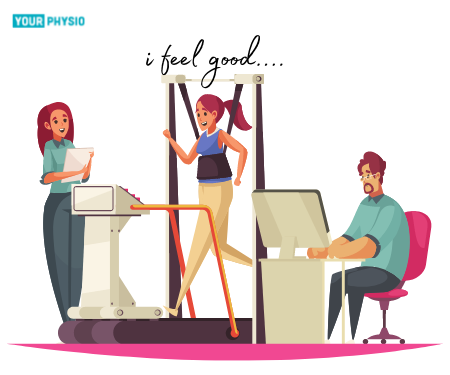Cardiac surgery involves opening up the chest of a patient. Also correcting the abnormality or increasing the lifespan of the person.
Physiotherapists have an important role after cardiac surgery. They help patients heal faster after cardiac surgery. They even play a vital role in the pre-operation or before cardiac surgery phase.
The heart consists of four chambers and is made up of cardiac muscles. Two of the upper chambers receive blood from different parts of the body. Whereas the two lower chambers pump blood to the different organs of the body.
There are four valves in the heart that prevent the backflow of blood. There are small arteries and veins that supply blood to the heart muscles. These help in the proper functioning of the heart.
Pacemaker is a device placed in the heart which helps in maintaining the rhythm of the heart.
A heart attack is most commonly caused due to a blockage in any of these arteries of the heart. A defect in the valves of the heart and any disease of the arteries need surgery.
The cardiac surgery might either correct the abnormality of the heart or place temporary replacement equipment to ensure the proper functioning of the heart.
Physiotherapy before cardiac surgery
This helps in decreasing the chances of complications during or after surgery.
They even provide the information to help in the smooth recovery of the patient.
Physiotherapy before cardiac surgery involves breathing exercises
The physiotherapist will teach you techniques of breathing well. These exercises are important during the recovery phase to prevent any lung complications.
Another advantage of these exercises is that it provides relaxation and decreases pain.
Cough removal methods- they help in the removal of cough and sputum from the lungs. This reduces the chances of any infection in the lungs after cardiac surgery.
General mobility- physiotherapists teach easy-to-do exercises. Usually, while lying on the bed to the patients before cardiac surgery.
Cardiac Rehabilitation
Physiotherapy after cardiac surgery is generally known as cardiac rehabilitation.
The goals of cardiac rehabilitation are:
Educating the patient about the importance of maintaining a healthy and active lifestyle.
Educating the patient about the ill-effects of alcohol consumption and/or inactive lifestyle
Helping the patient focus on exercising. To prevent the occurrence of complications after cardiac surgery.
Phase 1 of cardiac rehabilitation
Phase 1 of cardiac rehabilitation starts immediately after cardiac surgery. Usually in the ICU.
The physiotherapist will first assess you and give exercises based on it. Breathing exercises and lung clearance techniques are suggested. They help in managing pain and decreasing cough in the lungs. The presence of secretions like cough and sputum can delay the recovery of the patient.
Lung clearance techniques help in removing secretions of the lungs after cardiac surgery. The patient is given light activities to be done on the ICU bed itself. This contributes to faster recovery and discharges from the ICU.
Moving limbs, sitting on the bed with the back straight are a few examples. Neck and feet movements are also given, along with breathing and relaxation techniques.
The patient is even suggested appropriate positioning techniques on the bed. Helping in preventing bedsores and cough production in the lungs.
Phase 2 of cardiac rehabilitation
Phase 2 starts after the patient has been shifted from the Intensive care unit. Here the physiotherapist teaches the patient exercises. These exercises will help the patient return back to his normal life after discharge. This phase usually lasts for three to twelve weeks depending on the patient's ability and condition.
Turning on the bed and walking are some other prescribed exercises.
The do’s and don'ts after cardiac surgery are advised to the patient. Not lifting heavy objects, jogging, or running immediately after discharge. Not smoking or consuming alcohol, doing hectic activity, and taking adequate rest.
Phase 3 of cardiac rehabilitation
Phase 3 of cardiac rehabilitation. It starts after the patient is discharged from the hospital. It lasts until the next six months. This phase is called the maintenance phase. The main goal is to maintain and increase the health condition of the patient. So that he can perform his activities of daily life with ease.
The therapist asks the patient to walk, cycle, and perform Yoga. Maintaining a healthy diet and practising any other non-strenuous activity that interests him is also important. Active involvement of the patient's family members like parents, spouse, or children helps in the faster recovery of the patient.
Advantages of exercise during Cardiac Rehabilitation
The general fear of surgery makes the patients fear any kind of movement. Yet, it is proven that regular exercise after cardiac surgery is helpful. It helps in faster recovery and discharge of the patient.
Regular physical activity before and after cardiac surgery helps in:
Pumping blood from the heart to other organs of the body.
Increasing the patients' confidence in themselves
Maintaining heart rate, blood pressure, and respiratory rate
Prevents further complications of cardiac surgery and bed-ridden lifestyle from worsening
Also helps patients get back to their routine faster and effectively.

Illustrations designed by freepik